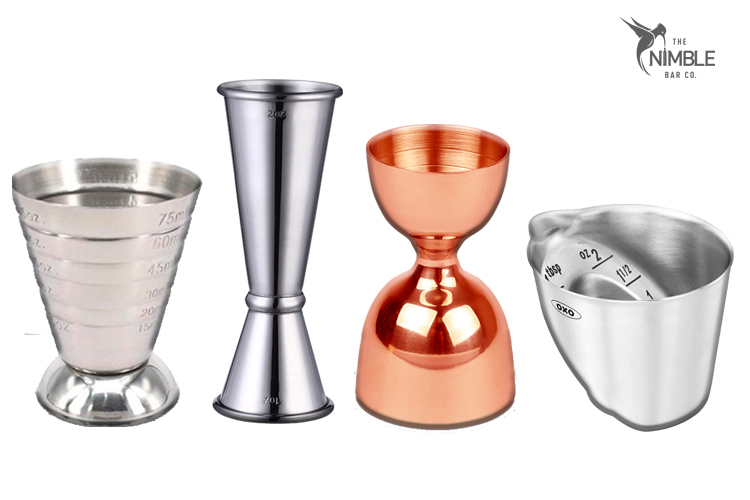In this in-depth guide on bar jiggers, we’re covering what a bar jigger is, cocktail jigger styles and sizes, how to use a jigger, where to buy jiggers, and more.
So what is a bar jigger, anyway?
A bar jigger is a tool to help you accurately and consistently measure alcoholic ingredients. They come in all different shapes, sizes, and materials.
More importantly, a bar jigger is the tool you’ll use most frequently as a bartender, and it will become part of your signature bartending style. From elegant Japanese-style stainless steel jiggers to the brash single shot glass pourer still widely used today, each jigger has its advantages and disadvantages.
In this guide, we’ll leave no stone unturned!

But first, why the hell is it called a ‘jigger’?
As is the case with any alcohol-related origin story — no one really knows.
The esteemed David Wondrich suggests that jigger was another word for “thingamajig” or “whatchamacallit”.
Gavin Smith writes, “The word ‘jigger’ is first recorded in 1824 as a slang term for an illicit distillery,” and goes on to mention that there are TONS of slang terms involving the word jigger.
The slang term that strikes me as the most likely origin for the bar tool is jigger worker — a vendor of illicit liquor. Makes sense that the device that doles out liquor could adopt the same name💡
Bar Jiggers are modeled off sherry wine glasses
While the naming is speculative, we know a bit more about what was used to measure liquor before we had these fancy ‘jigger’ things.
Bartenders originally used standard glassware to measure liquor.
For example, many recipes would call for a ‘wine-glass’ of spirit, which varied from about 1.25 oz to 2 oz of liquor.
And since a standard wine pour is 5 oz to 6 oz, and would be really awkward to use as a measuring device, they’re referring to sherry wine glasses.
Like this one:
Smaller pours called for a ‘pony’ which was usually used to serve brandy, liqueurs, cordials, etc. These looked similar to sherry glasses, but were a bit smaller.
And you can probably see how these ‘wine-glasses’ and ‘pony glasses’ could be a model for this…
Now that we know a bit about the history of jiggers, let’s get into the different styles of jiggers and how to use them.
The Bar Jiggers We Highly Recommend
Here are the jiggers we highly recommend:
- Multi-Level Bar Jiggers
- Oxo Measuring Cup Jiggers
- Japanese Precision Jiggers
- 1930s Vintage Bell Jiggers
Multi-Level Jigger
This is the jigger I’ve personally used for the last 5 years because it’s the perfect balance of functionality, elegance, and ease-of-use.
The No Spillage Advantage
Most jiggers require that you form a meniscus to get a perfectly accurate pour. Since we’re often moving quickly behind the bar, that can lead to spillage that adds up over time. Spillage isn’t only a waste of product, it’s also messy (and I don’t know about you but one of my biggest frustrations is sticky tools and surfaces).
This graphic from Uber Bar Tools illustrates the problem very well:
The multi-level jigger’s largest measurement is 2.5 ounces (45 ml) which is rarely used. In fact, if I had to pour 2.5 ounces of one ingredient, I’d pour 2 ounces, and then 0.5 ounces.
This may not seem like a big deal, but because all measurements are less than the largest measurement means that we don’t need a meniscus to form in order to get an accurate pour.
Which means NO SPILLAGE.
And I can use it in a way that I find comfortable, elegant, and functional.
The Single Basin Advantage
You’ll notice with the Japanese Precision Jigger and the 1930s Bell Jigger below that there are basically two different measuring devices welded together into one.
While this seems like a great 2-for-1 kind of deal, I find that it creates more mess and is technically more challenging to use.
With the single basin feature of the multi-level bar jigger, I don’t need to fuss around flipping my jigger around or even reaching for a different jigger for a different pour.
My jigger can stay in my hand and I can keep my eyes up because there’s less maneuvering required.
This Bar Jigger DOES Take Getting Used To
The measurement markings on the outside of this jigger can take some getting used to because at first it isn’t totally clear which line the numbers are referring to.
But if you can etch this image into your noggin, it should make it a bit easier!
Oxo Measuring Cup Jiggers
I often find that the Oxo measuring cup is the preferred measuring device for people who spend a lot of time cooking.
Similar to the Multi-Level Jigger, the Oxo Measuring Cup has a single-basin advantage, meaning less spillage and less maneuvering time.
The Oxo Measuring Cup is also one of the few measuring devices that features a 0.25 oz (7.5 ml) demarcation. The lowest measurement most jiggers have is 0.5 oz (15 ml) and we need to eyeball any smaller measurements.
An added advantage of both the Oxo and the Multi-Level Jiggers is that they’re sturdy, so they won’t tip over.
This is the jigger-of-choice for The Nimble Bar Co’s co-founder, Nathan Caudle. He has this to say about the Oxo Measuring Cup:
| “Sometimes bartenders scoff at it calling it the Fisher Price “my first jigger,” but pay them no mind. It is by far the most utilitarian with its wide mouth; allowing for long sweeping pours and cuts, and can even be placed stable level on a surface very quickly. We always believe in efficiency and cleanliness…and with this jigger, you can control your spillage and the sight lines for the graduations are dead easy to read…even from a distance. While not the prettiest in terms of style and form…it makes up for it huge in terms of ergonomics and easy learning curve.” |
Japanese Precision Jiggers
The Japanese Precision Jigger is probably the most popular among bartenders around the world.
It is essentially modeled off of the ‘wine glass’ and the ‘pony glass’ we mentioned earlier, with one on top of the other.
The Japanese Bar Jigger Requires the Most Skill
The Japanese Jigger takes the most skill to use in a way that’s clean because you need to form a meniscus in order to achieve an accurate 1 oz and 2 oz pour — this is no small feat when you’re moving fast.
In my own experience, when I use a Japanese Bar Jigger, I’m more messy (so more sticky
This jigger is also most conducive to jigger flair. The ball ring in the center makes it easy to move it around your thumb and fingers.
There are markings on the inside which require less dexterity. The narrow structure also makes it easier to handle larger measurements.
The Clutter Disadvantage
Many bartenders will have 2 of these at their station — a 2 oz / 1 oz variant, and a 1.5 oz / 0.75 oz variant. This gives them more flexibility and more measurements to work with.
But to me, this is a disadvantage because it causes a cluttered workspace (and more room for error).
All that said, when a bartender can skillfully use this jigger (or even two of these jiggers in one hand), the sleek and slender design make it the most elegant.
1930s ‘Leopold’ Bell Jigger
The 1930s Bell Jigger is essentially a different style of the Japanese Precision Jigger.
It has the same measurements on either side.
The feel of it is a bit heavier.
Recap Of Our Most Highly Recommended Bar Jiggers
Here’s a quick look at the advantages and disadvantages of each one:
| Advantages | Disadvantages | |
| Multi-Level Jigger | – Single basin – No meniscus needed – Elegant style | – Difficult-to-read demarcations |
| Oxo Measuring Cup | – Single basin – No meniscus needed – Sturdy – Easy-to-read demarcations | – Some say it’s a “Fisher Price” Jigger 😬 |
| Japanese Precision Jigger | – Great for ‘jigger flair’ – Very sleek and elegant | – Requires meniscus for accuracy – Can be messy – Learning curve |
| 1930s Bell Jigger | – Nicely weighted – Fits fingers well – Beautiful design | – Requires meniscus for accuracy – Can be messy |
I hope this helps 🙂 Let me know in the comments what your jigger of choice is! 👇
Sincerely,
Kyle Guilfoyle





